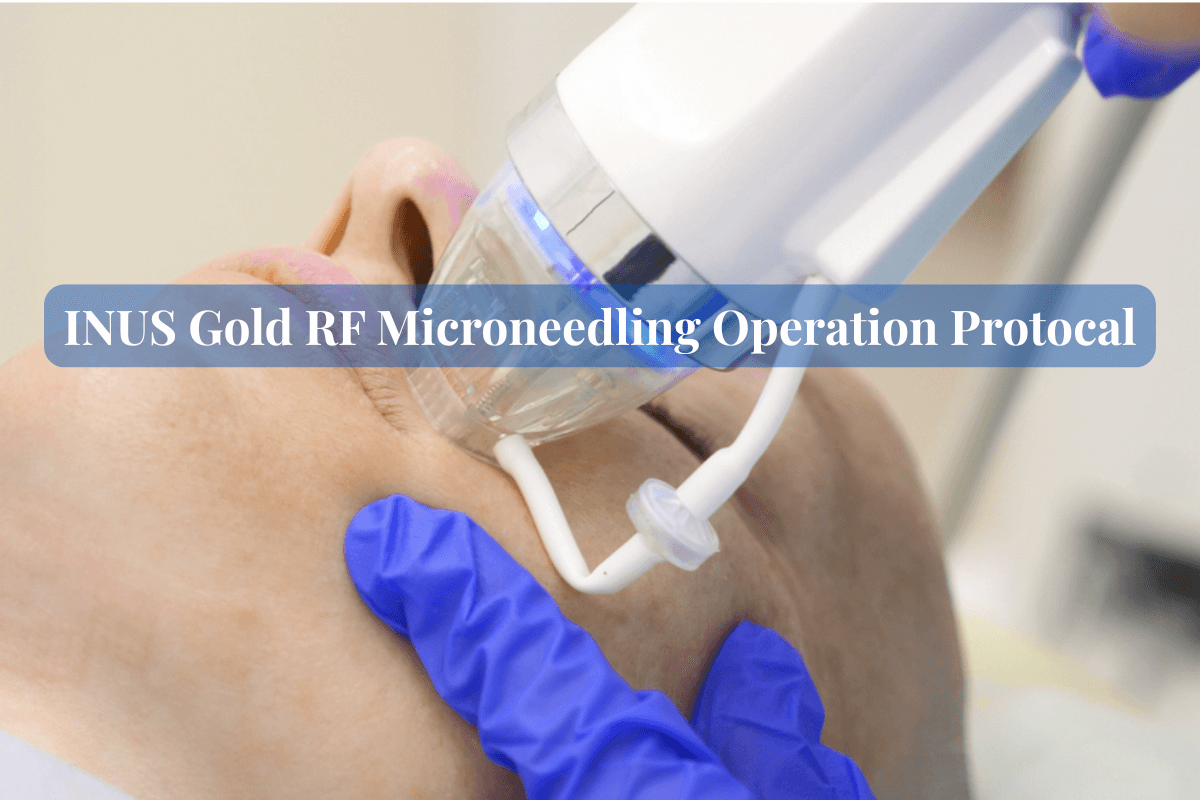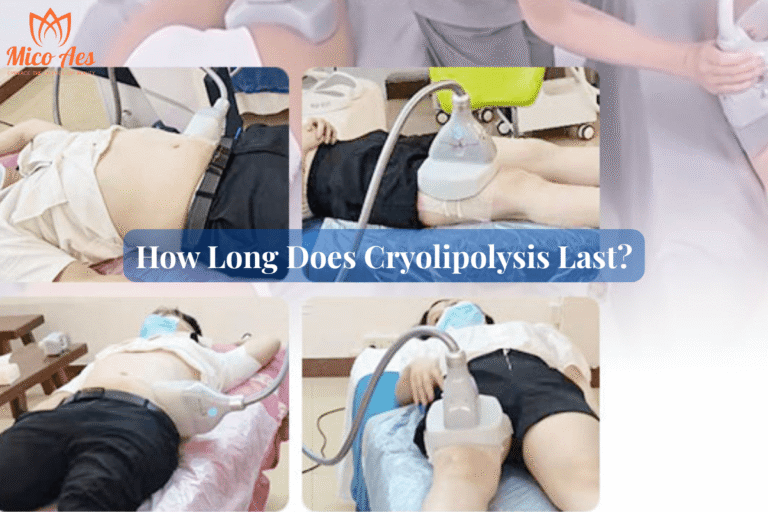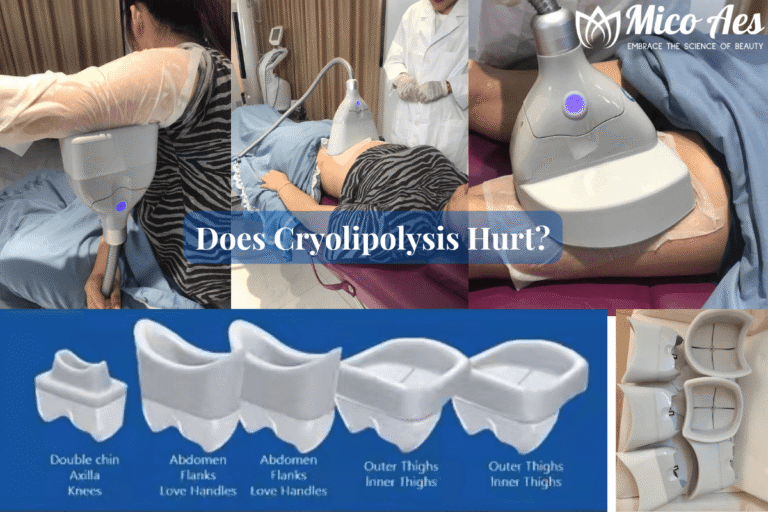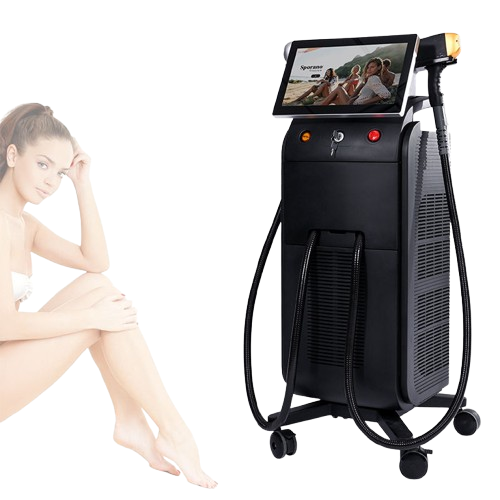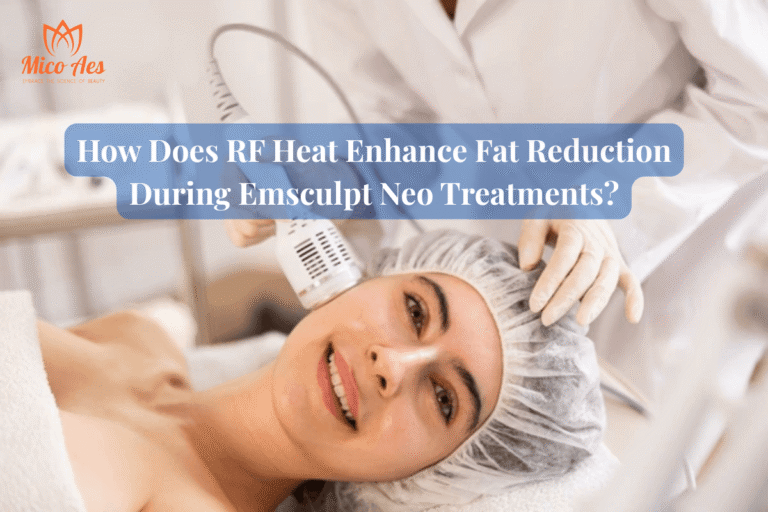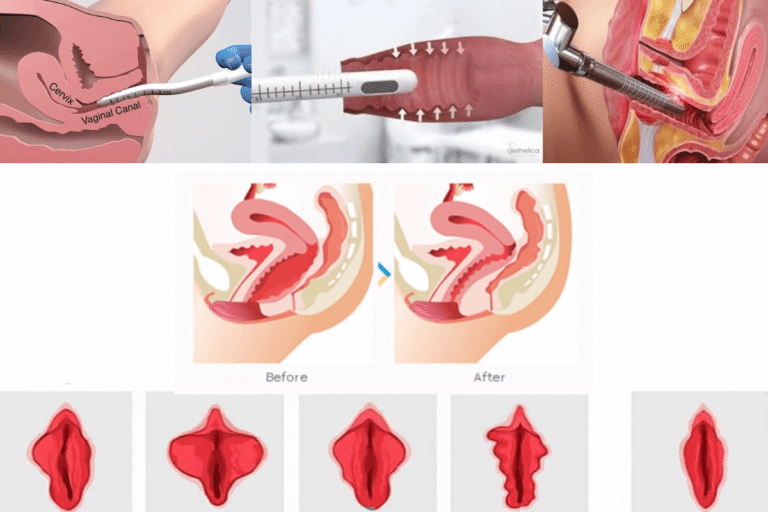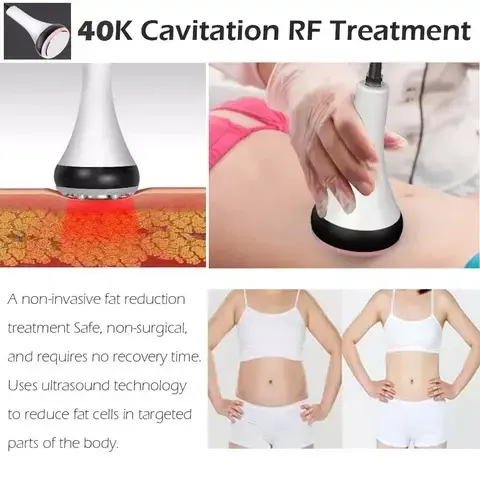1. Device Overview
INUS Gold RF Microneedling is an advanced aesthetic device that combines microneedling with radiofrequency (RF) technology. It precisely delivers RF energy into the dermis via microneedles to stimulate collagen and elastin production, improving wrinkles, tightening the skin, repairing scars, and enhancing overall skin condition.
2. Device Features
- Precision Energy Delivery: RF energy is only released when the microneedles contact the skin, minimizing epidermal damage by adapting to skin impedance.
- Insulated Needle Technology: Only the needle tips emit RF energy, ensuring targeted delivery and reducing side effects.
- Multiple Treatment Modes: Equipped with adjustable needle depths (0.5mm – 3.0mm), suitable for treating the face, body, scalp, and stretch marks.
- Safe & Comfortable: Gold-plated microneedles with vacuum-assisted suction reduce bleeding and pain, shorten recovery time, and lower the risk of post-inflammatory hyperpigmentation (PIH).
3. Core Technologies
- Dual-Frequency Bipolar RF: Offers 0.5MHz (deep, localized) and 2MHz (shallow, diffused) modes for precise dermal targeting.
- Insulated Gold Microneedles: 18K gold-plated needles ensure energy is focused at the tip, while the Micro Cell insulation prevents RF emission during non-contact.
- Vacuum Suction Technology: Smooths the skin during treatment, enhancing accuracy and minimizing bleeding.
4. Indications
- Acne scars
- Wrinkles
- Enlarged pores
- Stretch marks
- Dull or uneven skin tone
5. Standard Operating Procedure
(A) Pre-Treatment Preparation
- Patient Evaluation
- Contraindications screening: Contraindicated for pregnant or nursing individuals, patients with heart disease, diabetes, skin infections, keloid tendencies, or sunburn.
- Informed Consent: Fully explain the procedure, expected results, risks, and post-care to the patient.
- Photography: Take pre-treatment photos to assess treatment efficacy.
- Skin Preparation
- Discontinue anticoagulants (e.g., aspirin, ginkgo) 1 week prior; avoid alcohol and smoking.
- Remove makeup and metal accessories; wear loose clothing.
- Apply topical anesthetic (e.g., lidocaine cream) for 30–40 minutes, covered with plastic film to prevent evaporation.
- Disinfect treatment area with povidone-iodine and saline.
- Device & Needle Disinfection
- Soak needle tips in 75% alcohol for 5–10 minutes or spray with alcohol multiple times.
- Disinfect treatment area with alcohol gauze.
- Device Settings
- Select appropriate needle depth (typically 0.5–2.5mm) and RF energy level based on treatment area and skin condition.
- Adjust vacuum intensity and needle speed for safety and comfort.
(B) Treatment Procedure
- Use vacuum suction to fix skin in place, ensuring even microneedle penetration.
- Microneedles quickly penetrate the skin, deliver RF energy from the tip, and retract. Repeat until the area is fully treated (approx. 15–20 minutes).
- Operation Steps
- Settings:
- Eye area: 10-pin needle (0.6–0.8mm); Face: 25-pin needle (0.8–2.5mm)
- Start with low RF energy; mild erythema is ideal.
- Vacuum intensity: Level 1–3 (to minimize bleeding)
- Treatment:
- Activate vacuum, flatten skin, insert needles vertically.
- Move the handpiece evenly; for bony areas (forehead, cheekbones), keep depth ≤1.5mm and intensity ≤Level 8.
- Treat each area once; focus areas can be treated 2–3 times.
- Monitoring:
- Monitor skin impedance in real-time. Device stops if limits are exceeded.
- Use sterile cotton to press and stop any bleeding.
- Settings:
(C) Post-Treatment Care
- Gently press treated area with sterile cotton or gauze to stop bleeding.
- Apply repair gel or medical face mask; avoid face washing and sun exposure for 24 hours.
- Minor scabbing, redness, or heat may occur. Keep the area clean and avoid spicy food and alcohol.
(D) Treatment Schedule
One session every 28 days; one course typically includes 4 sessions.
6. Pre-Treatment Disinfection Protocol
- Skin Disinfection: Thoroughly clean skin. Use alcohol or disinfectant on the treatment area. For underarm treatments, use povidone-iodine.
- Device Disinfection: Soak microneedles in 75% alcohol for 5–10 minutes or spray repeatedly and air-dry. Clean and disinfect after use.
- Infection Prevention: Ensure all tools are sterile. Avoid contact with metal surfaces to prevent RF interference.
- Operator Hygiene: Wash hands with soap and water before treatment.
- Avoid Compromised Skin: Do not treat areas with itching, wounds, inflammation, or stretch marks.
- Post-Treatment Care: Use sterile masks, antibacterial toners, and serums to promote healing.
7. Safety Precautions During Treatment
- Pre-Treatment: Remove all metal jewelry and watches. Wear loose clothing.
- During Treatment: Keep RF handpiece in close contact with skin. Do not exceed intensity Level 8.
- Post-Treatment: Avoid strenuous exercise, saunas, hot baths. Let scabs fall off naturally.
8. Post-Treatment Management
(A) Immediate Care
Apply a cold medical face mask or cold mist for 15 minutes. Use growth factor gel. Avoid water for 24 hours.
(B) At-Home Care
- 0–72 Hours: Clean with saline, cold compress 3x/day. Apply antibiotic ointment if skin is broken.
- 1–2 Weeks: Daily hydration masks, physical sun protection. Avoid makeup and acid-based products.
- Avoid: Saunas, swimming, strenuous activity, rubbing the skin.
(C) Sun Protection & Hydration
Use SPF 30+ when outdoors. Maintain skin hydration to support healing.
(D) Diet & Lifestyle
Avoid alcohol for one week. Eat a light diet; avoid spicy or irritating foods.
(E) Contraindicated Populations
Treatment is not recommended for pregnant/nursing women, or patients with heart disease or diabetes.
(F) Monitoring
Closely monitor skin for abnormal reactions (e.g., worsening pain or redness). Seek medical attention if needed.
9. Indications & Contraindications
(A) Indications
- Facial rejuvenation: skin lifting and firming.
- Wrinkle reduction: crow’s feet, forehead lines, nasolabial folds, neck lines.
- Skin brightening: improves dull skin, pores, pigmentation.
- Scar repair: acne scars, burn scars, pitted scars.
- Stretch mark reduction.
- Skin regeneration: collagen stimulation and repair.
- Eye care: dark circles, under-eye bags, lower eyelid laxity.
- Regular maintenance for skin health.
(B) Contraindications
- Physiological Conditions:
- Pregnancy, lactation, menstruation
- Skin Conditions:
- Active acne, inflammation, infection, hypersensitive or dry skin, photosensitivity
- Keloid-prone individuals
- Systemic Illnesses:
- Heart disease, hypertension, diabetes, epilepsy, bleeding disorders
- On anticoagulants or undergoing chemotherapy
- Autoimmune disorders
- Implants:
- Metal implants (e.g., pacemakers, stents)
- Other electronic medical devices
- Other:
- Malignancies or pre-cancerous lesions
- Bleeding disorders or thrombophlebitis
- Active skin diseases (eczema, psoriasis, herpes)
- Psychiatric disorders
- Tattoos or permanent makeup in treatment area
(C) Operation Restrictions
Repeat treatments on the same area must be spaced at least 10 days apart. Avoid inflamed or open wounds.
(D) Precautions
Remove all metal jewelry before treatment. Avoid vigorous activities, heat, and alcohol post-treatment. Emphasize moisturization, sun protection, and post-care. For discomfort, apply cold compresses or take pain relievers. If pigmentation appears, enhance sun protection and return for evaluation.
10. Post-Treatment Care Guidelines
- Keep the area clean & dry: Avoid water exposure for 24–48 hours. Use sterile saline with cotton swabs if needed.
- Cold Compress: Apply 2–3 times daily for 15–20 minutes to reduce swelling or discomfort.
- Medications: After cold compress, apply growth factor gel. For broken skin, use antibiotic or burn ointment twice daily for 3 days.
- Sun Protection: Avoid sunscreen for the first week. Use physical sun protection (hat, umbrella).
- Facial Treatment Patients: Apply hydration masks and medical-grade moisturizers daily. Avoid irritating skincare products.
- Underarm Treatments: Wear loose, breathable clothing to reduce friction and sweat.
- Avoid Intense Exercise: No strenuous activity for 2 weeks. Avoid heavy lifting for 1 week (underarm cases).
- Avoid High Temperatures: No saunas or hot springs for 1 month.
- Nutrition: Increase intake of protein and vitamins to aid healing.
- Healthy Lifestyle: Avoid spicy food, maintain good sleep hygiene, abstain from smoking and drinking.
- Follow-Up: Visit the clinic for review after 1 week and 1 month.
11. Treatment Plan & Results Management
- Treatment Plan: Once per month; 3–5 sessions per course. Acne scars may require 4+ sessions.
- Expected Results: Fine lines improve within 1 week. Collagen regeneration peaks between 1–3 months.
- Follow-Up: Re-evaluation at 1 week and 1 month post-treatment for further adjustments.
12. Technological Advantages Summary
Compared to traditional microneedling, INUS offers:
- Precision: Insulated needles + impedance monitoring; energy deviation <5%.
- Safety: 50% less bleeding, recovery shortened to 3 days.
- Efficacy: 40% more collagen production, especially effective for depressed scars.
Important: Always follow the device manual. Only certified professionals should perform treatment. Parameter settings must be tailored individually. First-time treatments should use low energy levels for testing.

